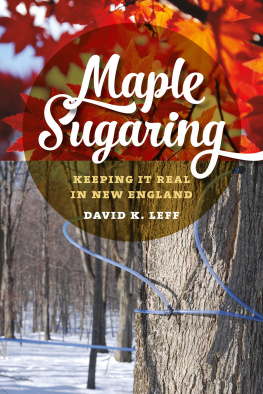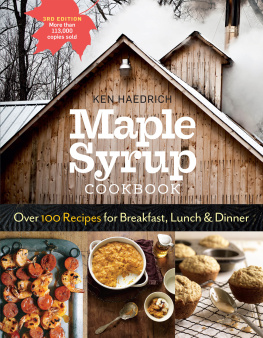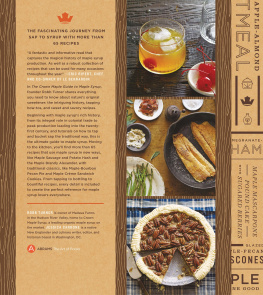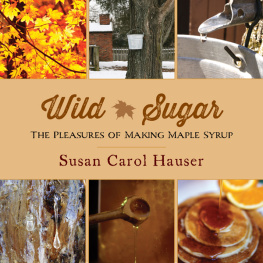
Maple Sugaring
Maple Sugaring
KEEPING IT REAL IN NEW ENGLAND
David K. Leff
Wesleyan University Press Middletown, Connecticut
Wesleyan University Press
Middletown CT 06459
www.wesleyan.edu/wespress
2015 David K. Leff
All rights reserved
Manufactured in the United States of America
Designed by April Leidig
Typeset in Monotype Bell by Copperline Book Services
Wesleyan University Press is a member of the Green Press Initiative.
The paper used in this book meets their minimum requirement for recycled paper.
Library of Congress Cataloging-in-Publication Data
Leff, David K., author.
Maple sugaring: keeping it real in New England / David K. Leff.
pages cm.(Garnet books)
ISBN 978-0-8195-7569-2 (cloth: alk. paper)
ISBN 978-0-8195-7570-8 (ebook)
1. Maple sugar industryNew England. 2. Maple sugarNew England. I. Title. II. Series: Garnet books.
HD9119.M32U54 2015
338.1'74972280974dc23 2014048354
5 4 3 2 1
All recipes included in this volume were published in The Maple Cookbook: Connecticut Style, compiled by the Maple Syrup Producers Association of Connecticut and edited by Jane Worthington (July 2012). Used with permission.
Cover photograph of sap collection tubing by David Leff
Contents
Preface
MAPLE SUGARING is a New England icon. Galvanized buckets hanging from trees above snow-covered ground and rising steam from an evaporator are among the most enduring, endearing, and engaging images of the region. A substantial amount of syrup is produced in other states, and by far most comes from Canada, but in the public mind New England is the maple capital. The following pages explore why.
Sugaring highlights and fosters a surprisingly wide range of classic New England characteristics. Among them are respect for deep history, Yankee ingenuity, connection to nature, affection for rural simplicity, sustainability, a strong work ethic, determination to prevail, hope for the future, savvy marketing, self-reliance, coping with variable weather, and delighting in homey foods. And while much nostalgia and some hyperbole are embedded in such attributes, they also remain remarkably viable. They are qualities from which readers in all walks of life and living anywhere in the world can draw inspiration.
There are many fine books on maple sugaring. Most of them are histories, personal chronicles, or about how to make syrup. This volume is not a history, a memoir, or a guide to producing a product. It partakes of some of these features, but more than detailing the past, the routines of sugaring, and the process of making syrup, I try to capture, however imperfectly, the indomitable spirit of those who tap and boil sap. Through my own experiences making syrup and the lively stories of many sugarmakers throughout the six New England states, I examine the sugaring way of life. I wanted to know what inflamed the passion of sugarmakers despite the hard work, yearly gamble with the weather, and other challenges.
Through the eyes of those who make syrup, scientists, government officials, equipment dealers and manufacturers, educators, and others, this book looks at community and family life, the advance of technology, heritage values, innovative products and nutrition, environmental issues like climate change and invasive species, marketing, the joy of trees and forests, agriculture as entertainment, and other matters. Doing so paints an impressionist-like picture of a landscape and its people.
Few activities so tightly bind culture and nature as maple sugaring. Rarely does an undertaking fuse the individuals involved so perfectly with the territory in which they live. With necessary conditions limited to a small corner of the planet, maple syrup is a true marker of place.
So long as sugarmakers inspire curious people to tap trees in their backyards or down the street, and children of all ages stand wide-eyed watching sap boil, maple syrup will embody the essence of New England. Join me discovering a labor of materiality and myth, space and time, muscle and soil, sweat and sweetness. New horizons beckon from a time-honored process.
Maple Sugaring
IS IT REAL MAPLE SYRUP? Thats my first question in an unfamiliar restaurant when I order pancakes, perhaps with a side of bacon and a couple of bulls-eye eggs. Not long ago, I perched myself on a stool in a silvery train-car-style eastern Massachusetts diner circa 1950 where the menu promised old-fashioned, home-style blueberry waffles. Perhaps not as good as what I could make in my own kitchen, but I was away from home and hungry. Besides, where better to have old-timey comfort food than a venerable eatery with gleaming stainless accents and terrazzo floors. For an extra buck you get maple made just a few miles away in the next town. Otherwise its the fake stuffAunt Jemima, I think, the ponytailed waitress said. I was glad to spend a little more. Otherwise it would have been an omelet and home fries.
Despite the regions long association with maple sugaring, even here in New England you have to ask if its the real deal, because some cost-conscious restaurants dont serve it. If youve grown up on maple syrup or acquired the taste later in life, you cant stomach so-called table or pancake syrup. They may advertise maple flavor, depict quaint cabins on their label, or have Vermont in their name, but they are viscous, cloying, and have a manufactured aftertaste. Maple syrup is made from the pure, clear sap of maple trees. While table or pancake syrups are not made from tables or flapjacks, as the names seem to suggest, they are generally concocted from corn syrup and may use sodium benzoate, cellulose gum, and artificial flavor with propylene glycol, sulfites, and dextrose. Used to be that sometimes a minuscule amount of actual maple syrup was added, but that seems largely a thing of the past. Sure, real maple syrup is a bit pricey, but when you discover the labor that goes into making it, its a bargain. I spent more than a decade of frenetic days, long nights, sweat and aching muscles finding out by running a small sugarhouse in the old mill village of Collinsville, Connecticut, once a world capital of axe and machete manufacture.
A couple of tablespoons or so of golden syrup hardly seemed sufficient when drizzled over my goodly stack of waffles punctuated with dark-blue fruity dots, but I poured it gingerly over the crispy grid of squares, knowing what little I was using took about a quart and a half of sap to create. Like in gold mining, where tons of rock are crushed, sifted, and treated to produce a few ounces of precious metal, a sugarmaker gathers large quantities of sap and by boiling and other clever innovations drives off the water and concentrates the sugar. Maple syrup is nothing more than condensed maple sap. The only added ingredientleaving no taste, color, or odoris the sugarmakers considerable labor. And usually that labor is itself the producers principal reward, for few earn much cash at it. Only a tiny percentage of big sugarmakers using thousands or even tens of thousands of taps will make a good living. The vast majority, hobbyists and small operators, make little or no money.
In spite of sugarings demanding bull work that might harden and obscure metaphysical notions, sugarmakers are a remarkably philosophic group. Regardless of the number of taps or size of the evaporator, sugaring is a seasonal rite of passage, a species of secular religion attaching a person to the larger cycles and rhythms of nature and life. Sugarmakers describe it as an addiction, a fever, even a contagious disease. Its easy to get hooked, almost impossible to stop. Getting a few dollars for their work is rewarding, but for most producers its not their principal motivation.
Next page






